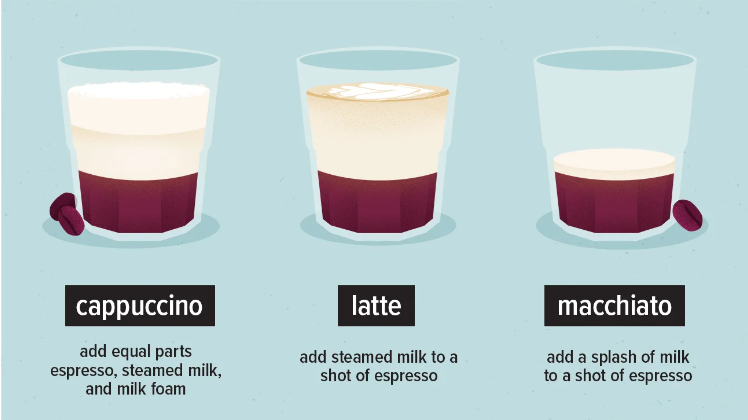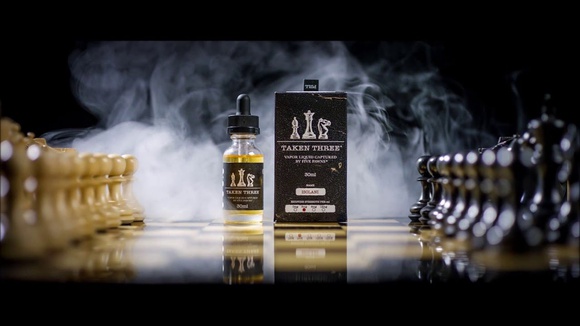
Cappuccino vs. Latte vs. Macchiato – What’s the Difference?
A latte, cappuccino, and macchiato all share a common ingredient: espresso. However, the way they’re prepared and their caffeine content differ, offering various tastes and textures.
Understanding the distinctions between these beloved coffee drinks, including their ingredients, caffeine levels, and nutritional value, can sometimes be perplexing, even for seasoned coffee enthusiasts.
Let’s delve into the key differences and similarities among cappuccinos, lattes, and macchiatos.
How They’re Made
The preparation method sets these three caffeinated beverages apart.
Cappuccino
A cappuccino, a beloved coffee classic, is crafted by layering a shot of espresso with steamed milk and milk foam. Typically, it consists of equal parts espresso, steamed milk, and foamed milk, creating a creamy and indulgent texture.
Latte
Derived from the Italian “café latte,” meaning “coffee milk,” a latte generally involves adding steamed milk to a single shot of espresso. Some variations include a light layer of foam on top, along with optional sugars or sweeteners. Lattes offer a mild, slightly sweet flavour due to their higher proportion of steamed milk.
Macchiato
Traditionally, a macchiato comprises a shot of espresso “stained” with a splash of milk. However, there are several variations, including the latte macchiato, where a shot of espresso is added to a glass of hot milk. With its minimal milk content, the macchiato delivers a robust coffee flavour and is smaller in size compared to other beverages.
Caffeine Content
All three drinks contain similar caffeine levels per serving.
Both cappuccinos and lattes, made with a single shot of espresso, offer comparable caffeine content. For instance, a medium-sized 16-ounce (475-ml) cappuccino and latte each provide about 173 mg of caffeine.
In contrast, a 2-ounce (60-ml) macchiato contains approximately half the caffeine, at just over 85 mg per serving.
Nutritional Value
The nutritional profiles of cappuccinos, macchiatos, and lattes vary based on their milk and foam content, as well as any added sugar or sweeteners.
Lattes, with their higher milk content, rank highest in calories, fat, and protein. Cappuccinos follow closely behind, offering a bit less milk but still providing substantial calories, protein, and fat per serving.
On the other hand, macchiatos, with only a splash of milk, are significantly lower in calories, fat, and protein.
Here’s a breakdown of their nutritional values per serving:
| Type of drink | Calories | Protein | Total fat | Carbs |
|---|---|---|---|---|
| 16-ounce (475-ml) latte | 206 | 13 grams | 8 grams | 20.5 grams |
| 16-ounce (475-ml) cappuccino | 130 | 8 grams | 5 grams | 13 grams |
| 2-ounce (60-ml) macchiato | 13 | 0.7 grams | 0.5 grams | 1.6 grams |
In conclusion, while cappuccinos, lattes, and macchiatos all start with espresso, their unique compositions offer a range of flavours and textures to suit every coffee aficionado’s palate. Whether you prefer the creamy richness of a cappuccino, the mild sweetness of a latte, or the bold intensity of a macchiato, there’s a coffee drink for every taste preference.
Ksenia owns her own dermatology clinic in London and is a nutritionist consultant. Ksenia is also a regular contributor to popular media outlets. In her spare time, she enjoys horse riding, clay pigeon shooting, rummaging in vintage stores and countryside walks.
[email protected]
- The Benefits of Chlorophyll - April 9, 2024
- Cappuccino vs. Latte vs. Macchiato – What’s the Difference? - April 9, 2024
- The Comprehensive Guide to the Benefits of Iron - October 16, 2023


